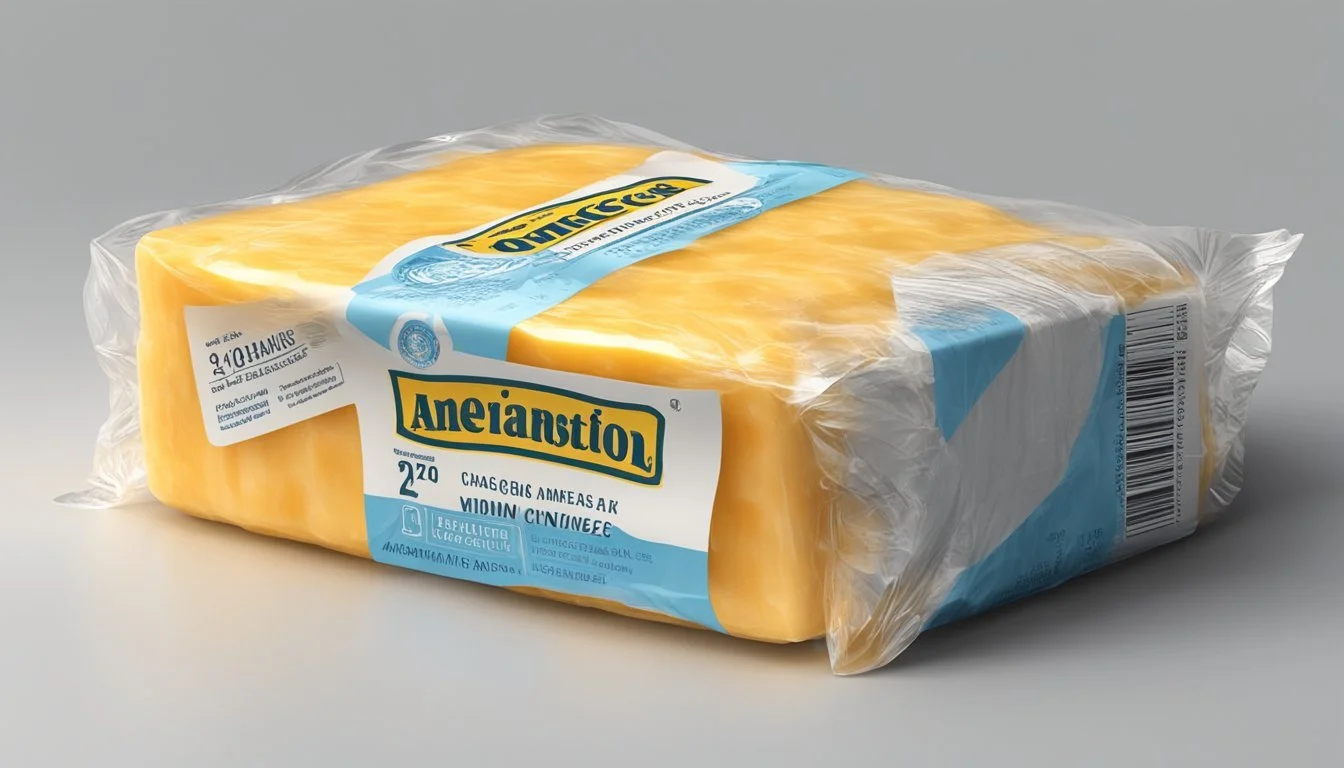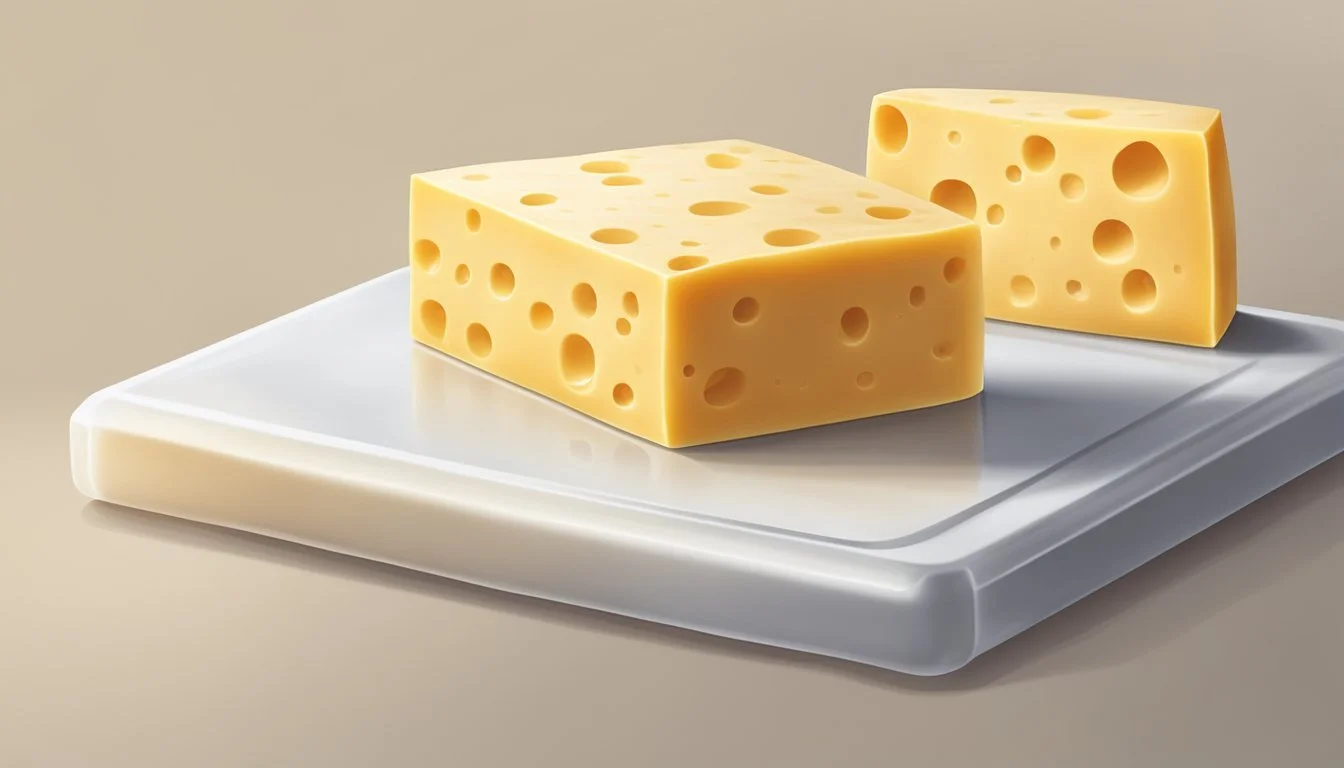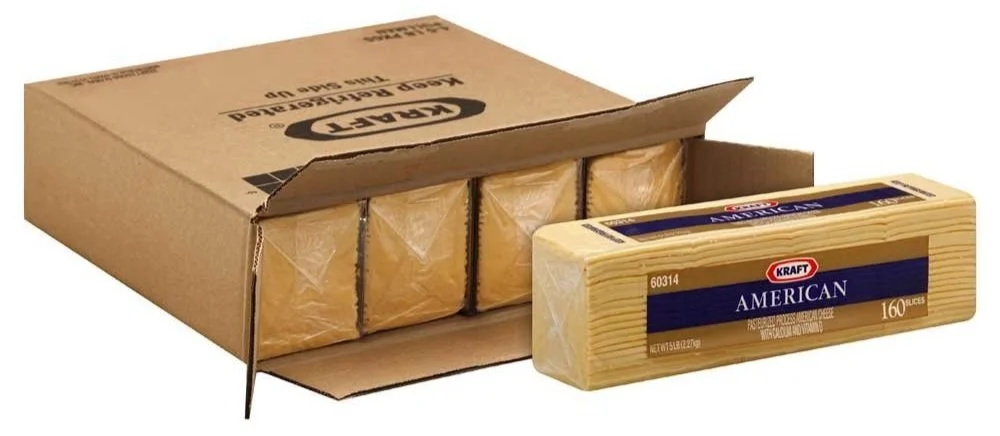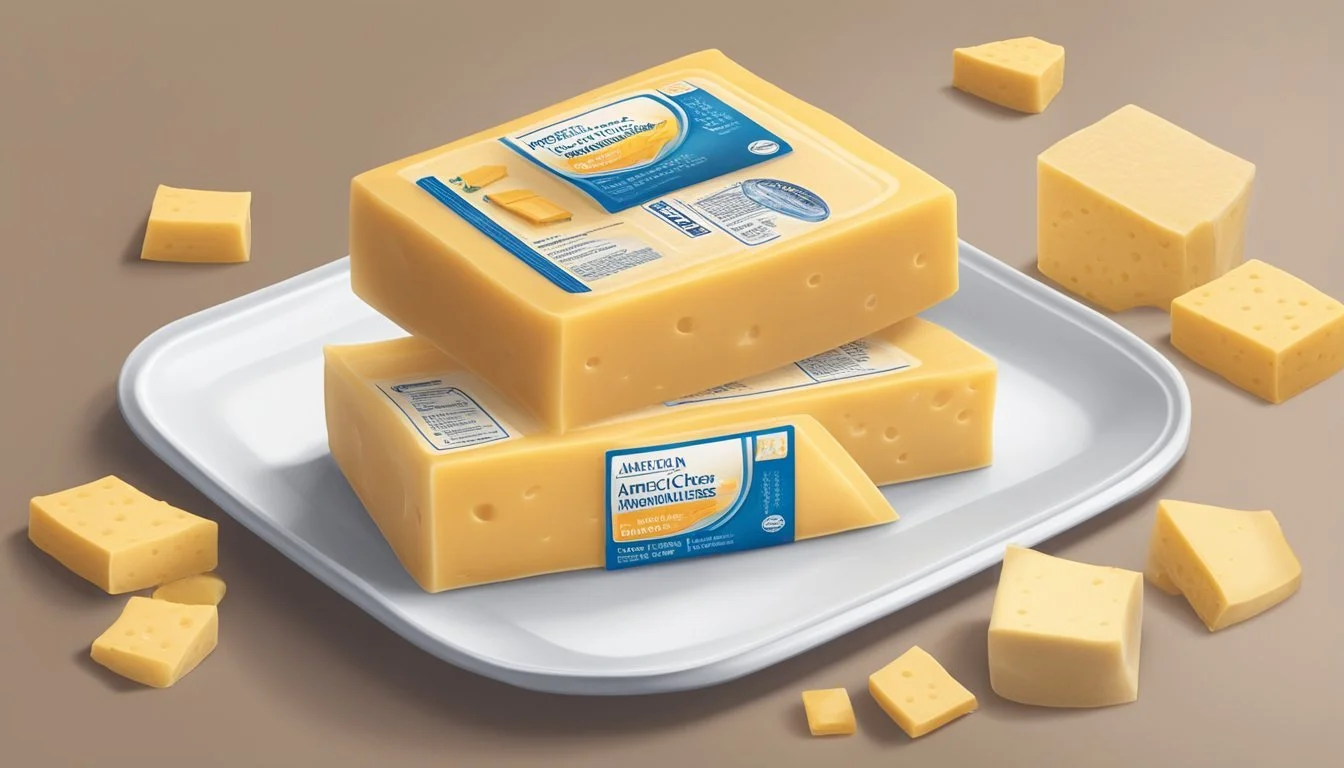How Long Does American Cheese Last?
Shelf Life and Storage Tips
American cheese (What wine goes well with cheese?), a staple in many households, is known for its creamy texture and meltability, making it a popular choice for sandwiches (What wine goes well with sandwiches?) and burgers. The shelf life of American cheese varies depending on factors such as the form it's sold in—whether as individual slices or blocks—as well as whether it is processed or 'real' cheese. Generally, unopened American cheese can last in the refrigerator for up to four months, while the individual slices should be consumed within two to three weeks after opening to maintain the best taste and quality.
Proper storage is key to preserving the quality and safety of American cheese. Keeping it at a constant temperature between 35-40℉ in the fridge is ideal to prevent spoilage. For consumers who value longevity, prepared American cheese products offer a relatively long shelf life, often lasting about six months in the fridge, and can be enjoyed without refrigeration until the package is opened.
Despite its longevity, it's essential to check the manufacturer's label for specific storage instructions and expiration dates, as these can provide the most accurate guidance on how long the cheese will last. Observing the texture, smell, and taste of American cheese is crucial; if any signs of spoilage are noticed, such as an off smell or a change in texture, the cheese should be discarded.
Types of American Cheese
American cheese comes in various forms, each offering a distinct taste, texture, and culinary use. From processed slices to traditional varieties, they cater to a range of preferences and dietary requirements.
Processed American Cheese
Processed American cheese, known for its smooth and creamy texture, is a blend of cheese curds, emulsifiers, and food coloring to create uniform slices. Key brands like Velveeta and Kraft Singles are recognized for their meltability, making them a staple for sandwiches and burgers. These are typically semi-soft in texture and are available in convenient pre-sliced packages.
Traditional Varieties
When it comes to traditional varieties of American cheese, one can find types such as cheddar, colby, and mozzarella. These range from semi-soft to hard cheese textures. Cheddar offers a sharp, pungent flavor, especially as it ages, while Colby is milder and perfect for a cheese platter. Mozzarella, on the other hand, is valued for its mild flavor and stringy, meltable quality in dishes like pizza.
Popular Brands
Numerous brands have become household names in the United States. For instance, Kraft Singles dominate the processed cheese market, recognized for their uniform melt. On the more traditional front, brands like Brie and Gouda offer softer options that are rich and suitable for sophisticated palates. They're often used in recipes that call for a more premium, nuanced cheese flavor.
Proper Storage Techniques
Proper storage of American cheese is critical for maintaining its quality and extending its shelf life. Employing the right strategies ensures that the cheese retains its flavor and texture.
Refrigeration
American cheese should be stored in the fridge at a consistent temperature between 35-40℉. For optimum freshness, once opened, consumers should store the cheese in an airtight container or securely wrap it with plastic wrap or aluminum foil. It's beneficial to label the cheese with the opening date to track its freshness period accurately.
Freezing Methods
For long-term storage, freezing American cheese is an effective method. Before freezing, one should wrap individual slices or blocks of cheese with wax paper or cheese paper, followed by a layer of foil or place them inside freezer bags. This process helps prevent freezer burn and cheese from absorbing other odors. Thawing should be done in the refrigerator to maintain texture.
Alternative Storage Options
In situations where refrigeration is not available or for preference, American cheese can be kept without cooling due to its processing. However, for best quality, it's advisable to avoid direct sunlight and heat sources. Storage in a cool, dark place is recommended, and the cheese should be consumed within a shorter timeframe compared to refrigerated or frozen cheese.
Identifying Freshness and Quality
To ensure the consumption of high-quality American cheese, it is crucial to evaluate its freshness through texture, color, and sensory cues such as smell and taste.
Assessing Texture and Color
When assessing the quality of American cheese, one should look for a uniform texture and consistent color. The texture should be smooth and slightly creamy to the touch, without any signs of dryness or crumbliness. If the cheese appears oily or if there's any separation of fats, this may indicate spoilage or degradation in quality.
Texture should be:
Smooth
Creamy
Color should be:
Consistent
Bright without dullness or discoloration
Smell and Taste Evaluation
The smell and taste are indicative of the American cheese's freshness and overall flavor profile. Fresh American cheese has a mild, slightly tangy odor that should not be overwhelming. If the cheese emits a sour or ammonia-like odor, it's likely past its prime. Taste is another reliable indicator; while it should have a mild and pleasant flavor, any sourness or off flavor is a sign of spoilage.
Smell should be:
Mild
Slightly tangy without sourness
Taste should be:
Pleasant
Mild, free from any off flavors
Shelf Life Determinants
The longevity of American cheese is significantly influenced by whether the package is opened and how it is stored. These factors can either extend or reduce the time frames during which the cheese remains fresh and safe to consume.
Unopened Packages
Unopened American cheese benefits from preservatives that extend its shelf life. Typically, an expiration date or best-by date is printed on the packaging, and it often signifies that the cheese can remain good for five to six months after production. When stored in a refrigerator, the constant temperature helps maintain its quality. To ensure optimal freshness, American cheese should be kept at a constant temperature between 35-40℉ (1.7-4.4℃).
Opened Cheese Longevity
Once the seal is broken, American cheese's exposure to the air accelerates the aging process. Opened American cheese should ideally be used within two to three weeks to enjoy its best taste and quality. The refrigerator plays a crucial role in preserving the cheese's lifespan post-opening. Keeping the cheese slices airtight and consistently refrigerated can help maintain the cheese's freshness for as long as possible within this timeframe.
Factors Affecting Spoilage
The longevity of American cheese is largely influenced by certain factors that can accelerate spoilage. Acknowledging the impact of bacteria and mold, the role of moisture and oxygen, and the importance of temperature control are crucial for preserving the cheese's quality.
Role of Bacteria and Mold
Bacteria and mold are primary agents contributing to the spoilage of American cheese. These microorganisms thrive on cheese and cause discoloration, off-flavors, and an unpleasant odor. It is the presence and activities of these microorganisms that lead to detectable changes, indicating that the cheese should no longer be consumed.
Moisture and Oxygen Impact
Moisture and oxygen are critical elements that affect the shelf life of American cheese. Excess moisture can promote the growth of mold and bacteria, which in turn speeds up the rate of spoilage. Oxygen exposure leads to oxidation, affecting flavor and potentially leading to spoilage. Proper packaging helps to minimize exposure to both oxygen and moisture.
Temperature Fluctuations
Steady temperature control is essential for preventing spoilage. American cheese should be kept at a constant temperature between 35-40°F. Fluctuations in temperature can lead to the growth of spoilage-causing microbes. Cheese should be stored in the coldest part of the refrigerator to maintain its freshness and slow down bacterial and mold growth.
Freezing and Thawing American Cheese
When one needs to extend the shelf life of American cheese, freezing is an effective method. Thawing must be done with care to preserve the cheese's texture and taste.
Instructions for Freezing
To freeze American cheese, one should ensure that each slice is wrapped individually to maintain quality. Wrapping can be done with plastic wrap or parchment paper. Once wrapped, the slices should be placed in a ` to protect against freezer burn. Here is a step-by-step process:
Wrap each slice of American cheese separately.
Place the wrapped slices into a heavy-duty freezer bag.
Expel as much air as possible from the bag by squeezing.
Seal the bag tightly after ensuring minimal air is trapped inside.
Label the bag with the date to keep track of how long the cheese has been frozen.
American cheese can typically be frozen for up to six months without significant loss of quality.
Take pleasure in the comfort of receiving heavy duty freezer bags at your doorstep with an online purchase!
Proper Thawing Techniques
Thawing American cheese requires patience. One should transfer the frozen cheese from the freezer to the refrigerator and leave it overnight, allowing it to thaw slowly. Rapid thawing at room temperature or using a microwave is not recommended, as it can lead to uneven texture and possible spoilage. Here’s what to remember:
Transfer the cheese from the freezer to the fridge the night before intended use.
Allow the cheese to thaw gradually in the refrigerator to maintain its consistency.
Use thawed cheese within a couple of days to enjoy its optimal taste and texture.
Signs of Spoiled American Cheese
Recognizing the signs of spoilage in American cheese is crucial to ensure safety and prevent food poisoning. Attention to visual cues, odors, and taste can help in identifying if the cheese has gone bad.
Visual and Textural Changes
Spoiled American cheese often exhibits noticeable visual changes, such as:
Mold Growth: The presence of any sort of mold, which could be green, black, or white spots, is a clear indication that the cheese should not be consumed.
Discoloration: Yellowing or darkening beyond the cheese's normal color might signal spoilage.
Dried Out Edges: Shriveled or hardened edges are typical of cheese that has gone bad.
Slimy Surface: A slimy or tacky feel to the touch indicates that the cheese is no longer fresh.
Off Smells and Altered Tastes
American cheese that has spoiled can also be identified by:
Off Smell: A sour or unpleasant odor that differs from its typically mild, creamy scent should raise concern.
Altered Taste: While tasting is not recommended as a primary test for spoilage, a sour or unusual flavor will confirm that the cheese is not fit for consumption.
Health Risks and Food Poisoning
Spoilage can put individuals at risk for:
Food Poisoning: Spoiled American cheese should be discarded as it can harbor harmful bacteria, leading to food poisoning.
Digestive Distress: Consuming spoiled foods, including bad cheese, might result in symptoms such as stomach pain, nausea, or vomiting.
When in doubt, it is always safer to discard questionable American cheese to avoid the health risks associated with spoiled foods.
Using American Cheese in Recipes
American cheese is a versatile ingredient that can enhance dishes with its creamy texture and mild flavor. Its melting properties make it ideal for warm recipes, while its smoothness fits well into cold applications.
Warm Dishes and Melting Properties
When heated, American cheese melts smoothly and evenly, lending a creamy texture to various dishes. This characteristic makes it a popular choice for hot sandwiches, such as classic grilled cheese sandwiches and cheeseburgers, where a uniform melt is desirable. It also integrates well into cheese sauces, providing a velvety consistency ideal for drizzling over nachos or blending into casseroles.
Sandwiches: For a grilled cheese, aim for medium heat to avoid burning the bread before the cheese melts.
Cheeseburgers: Place a slice of American cheese on the patty during the last minute of cooking to ensure perfect melting.
Cheese Sauce: Melt American cheese with a bit of milk or cream for a simple and smooth cheese sauce.
Casseroles: Layer slices of American cheese between other ingredients to create a gooey, melted texture throughout.
Cold Applications
American cheese's creamy nature also makes it a good fit for cold applications. Its soft texture means it doesn't overpower other components within a dish. Cold sandwiches, wraps, and salads can benefit from the addition of American cheese without the need for any additional preparation or cooking.
Cold Sandwiches: Layer American cheese with deli meats for a rich, yet not overpowering, flavor.
Burgers: Offer a slice of American cheese as an option for diners who prefer their cheese unmelted.
Salads: Dice American cheese into small cubes to add a smooth texture to a crisp, fresh salad.
By considering its melting qualities and soft texture, chefs can deftly incorporate American cheese into a range of recipes, whether served warm or cold.
Packaging and Labeling Information
When examining American cheese, the way it is packaged and labeled plays a key role in determining its shelf life. Typically, manufacturers package American cheese in sealed plastic wraps or wax paper to ensure freshness and prevent contamination. It is important to note that the original packaging, if kept intact, helps prolong the cheese’s longevity.
Labels on American cheese packages provide crucial information including the manufacture date and the "best by date." The manufacture date indicates when the cheese was processed and packaged, while the best by date serves as a guideline for consumers to understand the time frame in which the product is expected to maintain its optimal quality if stored properly.
Unopened, American cheese remains fresh for an extended period due to its sealed environment which protects it from exterior elements:
In the fridge: Approximately 4-6 months from the manufacture date.
Once the cheese is opened, the protective barrier is compromised, and storage recommendations change:
Opened in the fridge: Best consumed within 2-3 weeks for optimal taste.
Consumers should store American cheese consistently at temperatures between 35-40℉ (1.7-4.4℃), and it’s imperative to reseal the packaging between uses to prevent exposure to air and moisture, which can accelerate spoilage.
To summarize, the packaging and labeling of American cheese are integral to both its shelf life and the safety of consumption. By adhering to the guidelines provided on the packaging labels and storing the cheese under recommended conditions, consumers can best ensure the quality and longevity of their American cheese.
Health and Nutritional Considerations
When considering the health and nutritional aspects of American cheese, it's important to understand its content of additives and preservatives, its calcium and nutrient profile, and the implications of its consumption within dietary frameworks.
Additives and Preservatives
American cheese typically contains a variety of preservatives and additives to extend its shelf life and alter its consistency. These can include emulsifying salts, such as sodium phosphate, which help maintain the product's uniform texture. Annatto, a natural food coloring derived from the seeds of the achiote tree, is often added to give American cheese its distinct orange or yellow hue. Additives are a key factor in the product's longevity, with most American cheeses remaining safe to consume for several weeks when refrigerated properly.
Calcium and Nutrient Content
American cheese is made primarily from milk or milk-derived ingredients, such as whey or milk protein concentrate, and thus can be a source of calcium. Here's a brief overview:
Milk: The main ingredient that provides the base for the cheese.
Calcium: An essential mineral for bone health, present in cheese.
Whey: A protein-rich byproduct of milk that may be used in American cheese production.
The specific nutrient content can vary by brand and formulation, but American cheese commonly offers:
Nutrient Amount per 1 oz slice Calories 102 Carbs 1.3g Protein 5g Fat 9g Calcium Varies
Dietary Usage and Limitations
American cheese, when integrated into meals, should be consumed with consideration of its fat content and the presence of preservatives. Despite being a convenient source of protein and calcium, its typically high sodium and fat levels mean it should be used in moderation, particularly for those with dietary restrictions related to heart health. Additionally, individuals who are lactose intolerant or allergic to dairy should avoid American cheese, as it is derived from pasteurized or whole milk. Alternative cheese products made from sources like goat milk or composed of less processed cheeses, such as ricotta or cream cheese, might be preferable for certain diets.
1. If you can’t find these American cheese in your local markets, you can order online!
Tips for Prolonging Cheese Freshness
Proper storage is key to extending the freshness of American cheese. Here are some essential tips:
Temperature Control: Always store American cheese in the refrigerator, maintaining a steady temperature between 35-40℉. Fluctuations can affect the integrity of the cheese.
Unopened Packages: If the cheese is still sealed in its original packaging, it can typically last up to four months in the refrigerator.
State Fridge Storage Time Unopened Up to 4 months Opened 2-3 weeks
Opened Cheese: Once opened, it's best to use American cheese slices within two to three weeks. Keep them in a tightly sealed container or wrapped securely to prevent air exposure.
Avoid Contamination: Always use clean utensils when handling the cheese to prevent bacterial growth.
Freezing: For long-term storage, American cheese can be frozen. Wrap slices in plastic freezer wrap or aluminum foil and store in freezer bags.
Preparation Freezer Storage Time Wrapped Properly Up to 8 months
Remember that although freezing extends shelf life, it may slightly alter the texture of the cheese, affecting its meltability and taste upon thawing. For optimal flavor, it's recommended to use the cheese within its suggested refrigerated timeframe.
Conclusion
In assessing the lifespan of American cheese, one must factor in storage conditions and whether the cheese is opened or unopened. When stored unopened in the refrigerator, American cheese typically remains at optimal quality for up to four months. Upon opening, it is recommended to consume American cheese within two to three weeks to enjoy its peak flavor and quality.
Storage Guidelines:
Refrigerate at a constant temperature between 35-40℉.
Keep the cheese in its original packaging or wrap securely in cling film or aluminum foil after opening.
It is essential to recognize the signs of spoilage in American cheese, which include:
Texture Changes: Discoloration or the presence of mold indicates spoilage.
Odor Changes: An off-smell distinct from its milky, buttery aroma suggests it's time to discard the cheese.
Different varieties of American cheese may have a slight impact on its shelf life:
Pre-packaged Slices: Often last longer due to added preservatives.
Deli-sliced: May have a shorter shelf life as they are exposed to air and contaminants more frequently.
Lastly, maintain the quality and flavors of American cheese by adhering to proper storage practices. Consuming within the recommended time frame ensures that the cheese's characteristic creamy and mild taste is preserved, providing the desired richness to a variety of dishes.












